Fontainebleau
Town and History
A name that is famous in the entire world, a magical name that evokes for some a forest, for others a chateau… a name which still shines from its royal history.
For Fontainebleau, though it no longer welcomes sovereigns as it did for so long, remains a place where life is pleasant, a place where the expression “quality of life” takes on its full meaning.
Very close to Paris, the Fontainebleau forest welcomes 13 million visitors each year. Despite this considerable number, hikers, rock-climbing or mountain-biking enthusiasts, horse riders, cyclists and Sunday walkers come here for its wild landscapes. Fontainebleau was the royal hunting residence before the first lights of the Renaissance shone here under Francois 1st, in the heart of the Palace which all sovereigns, right up to Napoleon III, cherished, decorated and embellished through the work of their best artists, painters, sculptors, architects, fountainers and gardeners.
At the heart of these landscapes a city was born where side by side lived the Royal Court, His Majesty’s suppliers, the cooks for His table, and the cavalry responsible for His security and hunts.
It was among these landscapes too that, last century, the great Parisian bourgeoisie came for country stays by the forest on the shores of the Seine and the Loing, whilst young painters settled into the neighbouring villages. They had left the capital and the studios of the official school to come and paint in the midst of nature, with their easels among trees and rocks, facing the plain of Briere’s landscapes. And in the evening, they would return to Barbizon at father Ganne’s, to Bourron Marlotte or Moret-sur-Loing. The pictorial adventure of Barbizon and of the first impressionists such as Corot and Sisley were to open the road to a long line of artists, musicians and writers throughout the century, from Alfred de Musset to Cocteau, from Picasso to Cezanne or from Rosa Bonheur to Lalanne…
If there is a view which can evoke Fontainebleau’s uniqueness, it is the one you have early in the morning from the Chateau’s park when facing the ornamental lake of the Tiber. In front of you, a bronze statue moulded in the Renaissance… Further beyond, the contrast of the garden’s trimmed boxtrees with the untidy skirts of the forest. Finally, in the very background, passing horses, wanderers, training sportsmen… or ghosts of a royal hunt.
Capital of the history of France
Fontainebleau alone can aspire to such a title. Indeed, no other royal chateau in France can boast of having welcomed 34 sovereigns, from Louis VI “Le Gros” to Napoleon III.
All the French sovereigns have come to Fontainebleau. Autumn was the habitual hunting season and the Royal Court’s regular sojourn. The domain can thus be considered as their family house. Napoleon expressed it best: “here is the real abode of the kings, the house of centuries”, he said to Sainte-Helene, recalling the place he had so dearly cherished.
Located at the end of the Brie plateau and close to Paris, which the Capetians had made their capital, the Fontainebleau forest had always been known as an exceptional hunting domain. Sovereigns thus cultivated here the art of hunting, a tradition that is still continued…
Fontainebleau’s name itself is related to stag-hunting, since according to legend the “Fontaine-Belle-Eau” (Beautiful Water Fountain) or the “Fontaine-Bliaut” is named after the owner of the dog, or the dog itself, which discovered it during a hunt. It was close to this fountain in a clearing at the forest’s heart that a first hunting rendezvous was established at an unknown date, but before 1137, as a charter of King Louis VII was recorded that year in Fontainebleau.
The kings rapidly settled into their new mansion: Philippe Auguste, Saint Louis and even Philippe “Le Bel”, who was born here in 1268 and died here following a riding accident. But it was only with Francois 1st that Fontainebleau took on its full importance as a Royal Place.
Six sovereigns in particular marked the history of the chateau:
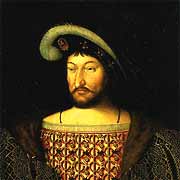
Francois 1st (1494-1547)
As he enjoyed staying in its « delicious deserts », it was he who gave the palace its general plan. Keeping only the ancient medieval dungeon, he asked Gilles Le Breton to create 2 groups of buildings: one on the ancient foundations which outlines the Oval Courtyard and the other around an immense courtyard named the Basse Cour (now Court of Farewells).
In the gallery that links them the king decided to carry out the most exceptional works, through the rivalry between the Florentine Rosso, a student of Michelangelo, and the Bolognese Primaticcio, disciple of Jules Romain. The result is one of the masterpieces of the French Renaissance and the manifesto of the first School of Fontainebleau. On the ground floor of his gallery, Francois 1st had Baths installed where he liked to come and admire his collections, including a painting already famous in the entire world: the Mona Lisa… The construction of the chateau continued in the reign of his son, Henry II, who finished the Ballroom considered to be the other marvel of the Renaissance. Though the royal mistress Diane de Poitiers managed for a time to hand over the building and design works to Philibert Delorme, the queen Catherine de Medicis re-attributed them to her compatriot at the king’s death.
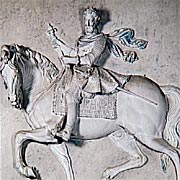
Henri IV (1553-1610)
He regularly resided in Fontainebleau and several children of France were born here, including the eldest son, the future Louis XIII. Henri IV created the court of Offices, the architecture of which recalls the contemporary Place Royale in Paris (since become the Place des Vosges). He remodelled the gardens, had the Grand Canal dug, and entrusted with the decoration of his apartments Flemish artists such as Ambroise Dubois and French artists such as Martin Freminet, who together formed the second School of Fontainebleau.
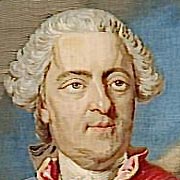
Louis XV (1710-1774)
Passionate about hunting, he came here every autumn of his reign to hunt stag. He considerably modified the chateau, where he married in 1725, by creating small apartments in the style of the period and by having Gabriel demolish and reconstruct a wing of the Court of Farewells to host his suite. Habitual transformations for a royal chateau, but which saw Primaticcio’s frescos disappear from the still famous Ulysses Gallery.
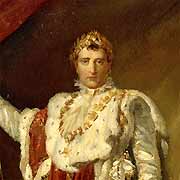
Napoleon 1st (1769-1821)
The emperor returned to Fontainebleau its vocation of “sovereign” abode. He refurnished the apartments, transformed the King’s bedroom into the Throne room and in 1804 welcomed here Pope Pius VII who had come to anoint him. He held the Sovereign Pontiff here anew from 1812 to 1814, this time as a prisoner. He spent the last days of his reign here before abdicating on 18 April 1814. The salon of the Abdication and the court (which has since become the Court of Farewells) remain places of pilgrimage for imperial history enthusiasts.
Louis Philippe (1830-1848)
He was the first sovereign to decide on a general restoration of the Palace, in order to make it a setting befitting the wedding of his son, the Duke of Orleans, in 1837. The Renaissance decors were restored and even improved with the creation of parquets and ceilings in the style of the period.
Napoleon III (1851-1870)
With the restoration of the Empire in 1852, Fontainebleau regained considerable importance. The new emperor frequently came to the country with the Court, and pursued the chateau’s restoration without respite (Diane’s Gallery, Francois 1st Gallery and Trinity Chapel).
He organised numerous building works for his enjoyment, including a theatre (still in its original state) and a Chinese museum to host Empress Eugenie’s collections. Since the end of last century, the restoration works on the buildings and gardens have been continued, in particular with the Rockefellers’ patronage to save the Beautiful Chimney wing. The collections have been completed through an active purchasing policy (Emperor’s porcelain dinner service).
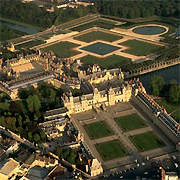
History of the Chateau
THE CHATEAU: 8 centuries of the History of France. A Chateau inhabited by all sovereigns since the Middle Ages: Kings, Queens, Emperors and Empresses cherished this place, and all left traces of their passage. Today, Fontainebleau offers visitors its architectural treasures, its decors, its paintings and the thousands of fascinating and precious objects that it has preserved.
State Apartments
Wealth and variety of interior decors of the royal apartments from Francois 1st to Napoleon III.
The Renaissance:
The decors of the Francois 1st Gallery, the bedroom of the Duchess of Etampes, the Ballroom… which made of Fontainebleau a centre of artistic influence in all of Europe.
Francois 1st, patron of the arts:
The patron king of Arts and Literature is evoked in the very setting where he welcomed Rosso, Primaticcio, Cellini, Bude…
Henri IV and the artists of his time:
Prolific builder, Henri IV considerably enlarged the chateau (court of the Offices, Deer gallery, aviary, canal, gardens… employing Dubois, Freminet, Dubrueil, Jacquet…) The Fontainebleau School and the art of the 16th century. An in-depth study of the decors of the 16th century. How artists come from all over Europe imagined a new decorative system in Fontainebleau.
The evolution of the apartments of the sovereigns
Napoleon in Fontainebleau:
The Emperor’s stays in Fontainebleau, daily life and government.
Celebrations and entertainment:
Hunts, tournaments, celebrations and grand ceremonies, with an overview of Real Tennis.
The royal hunts:
The sketches of Oudry, for a series of tapestries ordered by Louis XV; apartments of Hunts.
The history of the chateau:
Tour of the exteriors to reconstitute the history of the construction of the Palace, from the Middle Ages to the 19th century.
Stories and legends of Ancient times in Fontainebleau:
For school students
Small Apartments
Suites of Empire furniture and daily life of the Emperor in the more intimate setting of the Small Apartments.
The Francois 1st gallery:
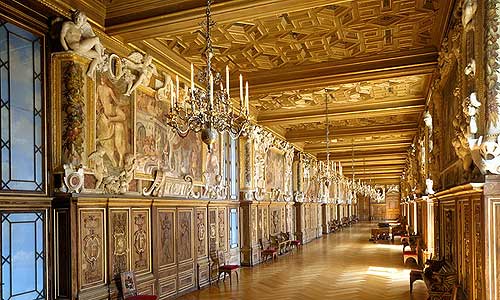
The ballroom:
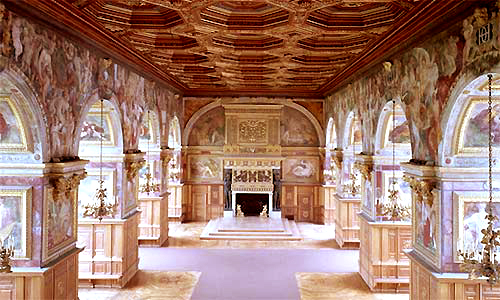
TheTrinity Chapel:
Exceptional for its frescos painted under Henri IV by Martin Freminet, one of Michelangelo’s little-known emulators, the chapel holds the memory of Louis XV’s wedding with Marie Leszczinska in 1725 and of Louis Napoleon’s baptism, future Napoleon III in 1810.
The Queen’s Grand Cabinet and the Queen’s Boudoir:
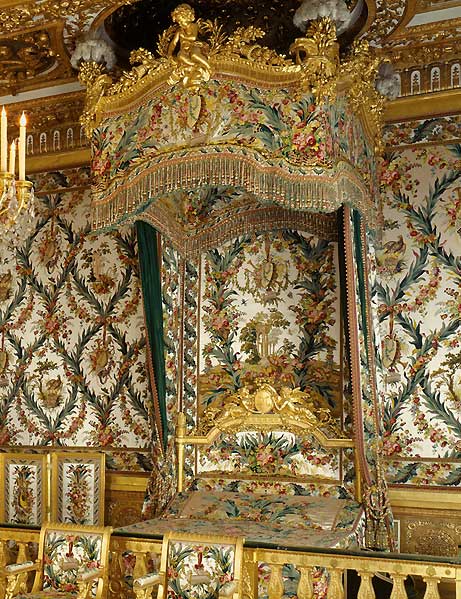
The Council Room:
Exceptional rockwork decor in pink and blue camaieu painted by Carl Van Loo and Jean Baptiste Pierre, with the ceiling by Boucher symbolising the Four Seasons. This room hosted the King’s councils, and later the Emperor’s.
The Throne Room:
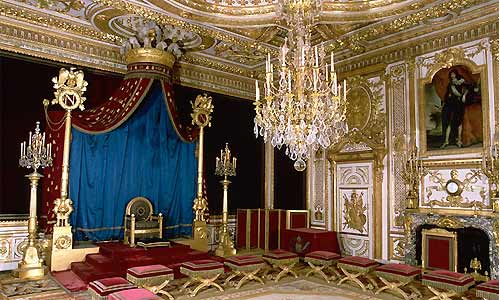
Napoleon 1st’s Imperial Inner Apartment:
Napoleon resided in these private apartments, which have just been refitted following fifteen years of restoration. One can discover the very beautiful bedroom of the Emperor and his display bed, his study where he worked during his nights of insomnia, his bathroom and the drawing-room which became famous since he signed his abdication there in 1814.
The Museum of Napoleon 1st:
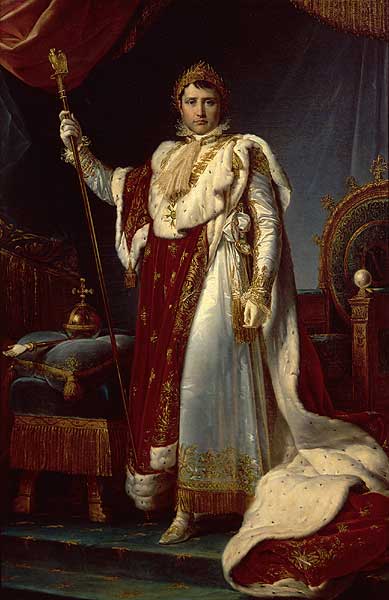
The Chinese Museum:
The Chinese collections gathered by the Empress Eugenie are exceptional by both their origins and their sheer quantity. In 1863, Napoleon III’s wife had the ground floor of the large pavilion redesigned in order to host her personal collection of objects from the Far East. The restoration undertaken in 1984 has highlighted to its advantage the Napoleon III decor of the rooms, designed as a museum, but also as a Second Empire salon with its red and green harmony…
The Courtyards
The Palace buildings are organised around five main courtyards, and the complexity of the plan reveals the various different work campaigns that were undertaken here. Indeed, each area has several names according to the different periods.
Arrival by the Court of the White Horse or Court of Farewells:
The main facade, punctuated by high-roofed pavilions, dates in part back to the 16th century. It was here, at the foot of the famous double horse-shoe staircase built in 1634 by Jean Androuet Du Cerceau, that Napoleon made his celebrated farewell to his guard before leaving for the Island of Elba.
Court of the Fountain:
The buildings bear witness of several periods of construction: the gallery of Francois 1st, the terrace of Henri IV, the apartment of Henri II, the elegant building of Primaticcio with its two right-banister staircases, facing the large pavilion of Gabriel built in 1750. The large dogs of Fo mark the former entrance to Empress Eugenie’s Chinese rooms. Near the carp pond is a fountain which used to give very pure water, the usage of which was reserved for the king. Rising in the middle of the carp-filled pond is a pavilion first built under Henri IV, then rebuilt by Louis XIV and restored by Napoleon 1st. Light meals were served there during royal outings.
The Oval Court:
The oldest courtyard in the Chateau lies in an area formerly occupied by the ancient 12th century fortified castle, of which only the dungeon remains. Primitively oval, this courtyard was opened by Henri IV who had the large domed portal elevated in 1601 to allow him a monumental entrance. The portal took on the name of Gate of the Baptistery, or Dauphine Gate, following the Baptism of Louis XIII which took place in the courtyard in 1601, the royal Court having fled Paris which was being ravaged by the plague.
Court of the Offices:
Said to be the court of Henri IV, in brick and rough-cast, built between 1606 and 1609 to shelter the offices and the kitchens by separating them from the main buildings to avoid fire risks...
The Gardens and the Ornamental Lakes
Like the buildings, the gardens of Fontainebleau have undergone numerous changes at the mercy of fashion, political will, lack of maintenance or anarchic plant development.
Diane’s Garden or the Queen’s Garden:
Until Louis Philippe, a space completely closed in by an orangery built by Henri IV in brick and stone, like the remaining building which hosts the Deer Gallery on the ground floor and the Diane Gallery on the first. In the centre of the garden, one can discover Diane’s Fountain (1602), topped by the statue of the goddess of hunting and surrounded by four bronze dogs come from the Louvre where they had previously been installed.
English Garden:
Formerly the Pine Garden, this garden was redesigned in the English style in the 19th century and its broad lines were developed under Napoleon 1st, with an artificial river running through it. Towards the back of it, an ornamental lake marks the site of the legendary “Fontaine-Belle-Eau”.
The Carp Pond:
This was once a swamp, which Francois 1st had transformed into a decorative lake, thus launching the “mirror of water” fashion much favoured by the French before being imitated all over Europe… As in all European royal domains, the lake is populated by carps reserved for the sovereign’s table.
The Grand Grounds or the Grounds of the Tiber:
Conceived by Le Notre, this is a French style garden which has unfortunately lost its boxtree decor. The landscape opens onto two perspectives:
- One towards the forest where a widening of the terrace receives the ornamental lake of the Tiber
- The other, towards the canal, above the ornamental lake with the waterfalls.
- Beyond and below lies the grand park which extends into the forest.
The Grand Park and the Grand Canal:
A surface of 84 hectares, with linear paths, star-shaped crossroads and a large canal approximately 1200m long, built under Henri IV.
The Real Tennis Room:
Considered the oldest of the three other remaining such rooms in France, its origin goes back to the 14th century in the reign of Francois 1st. This sport, the ancestor of tennis, then became “the game of kings, the king of games”.
There are many currently used French expressions which have their origins in Real Tennis: “qui va a la chasse perd sa place” (he who goes hunting loses his place), “tomber a pic” (to happen in the nick of time), “epater la galerie” (to impress the gallery)… These days, the Real Tennis room regularly welcomes tournaments and enables enthusiasts of this sport to play there all year long.
The success of tennis as we know it today is in large part due to Real Tennis. In 1604, Sir Robert Dallington, returning from France, wrote: “the country is strewn with real tennis rooms: they are more numerous than the churches; the French are born with a racquet in their hand; there are more tennis players in France than beer drinkers in England. (View of France).” One counted no less than a dozen active real tennis rooms in Paris’ rue de Seine alone at the start of the 17th century. Fontainebleau was not lacking with its two real tennis rooms in the palace. The kings of France played there during their stays: game of kings, king of games. The best players came there to demonstrate their talent. One of the last sovereigns to be passionate about real tennis was Napoleon. Fontainebleau is therefore lucky to have at its disposal a place of memory where ball exchanges are steeped in history.
The passion of the French for this game has faded but it has left traces in our cultural heritage, traces which bear witness to its vitality. There are numerous commonly used French expressions originating from Real Tennis: “qui va a la chasse perd sa place” (he who goes hunting loses his place), “tomber a pic” (to happen in the nick of time), “epater la galerie” (to impress the gallery)…
The English, being practical people, adopted ‘open air Real Tennis’ in 1870. Lawn tennis was born from the idea of a real tennis player from Marylebone Cricket Club, to simplify the rules of real tennis and play it outside.
Widespread in all of Europe after the Renaissance, real tennis is played today in Anglo-Saxon countries: the UK, the US, Australia, and in France, its country of origin. There is renewed interest in the sport as evidenced by new room openings in Melbourne and London. As for Fontainebleau’s room, returned to its destiny in 1990, it was only silent for 80 years: a mere interlude for its four centuries of history.
During the tour the lecturers, themselves real tennis players, will help you to discover and understand the world of real tennis through its history, its rules and the players’ demonstrations.
The third Museum of Military Art and History in France
The Museum of Military Art and History was created in 1963, following the death of Maitre Le Prost, well-known collector and great producer of Fontainebleau’s historical celebrations before the last world war, by his son Maitre Prost. Purchased for the municipality, the Napoleonic Museum is located in the Villa Lavaurs on Rue Saint Honore. The town councillors wished to bring together here the Museum of Uniforms, created by the well-known military painter Hugo de Fitchner, with the Napoleonic Museum. Thanks to the extraordinary value of the assembled works, the museum can claim to be the third most important military museum in France.
Room n°1: is reserved to the 1st Empire, Officers and soldiers of Napoleon’s Old Guard.
Room n°2: presents several objects that belonged to the Emperor.
Room n°4: the music, the musicians, the trumpets and the uniform-cases create a charming ensemble for visitors. Of particular note among the instruments, two bassoons in excellent condition and a Chinese hat from the 1st Empire.
Room n°5: it’s a dazzling sight, the history of the evolution of side arms presented to hand, from Louis XIV to 1914.
Room n°6: from the musket to the 1914 shotgun, from the wheel-lock pistol to the pistol of the year XIII.
Room n°7: The main themes of this room are the conquest of Algeria and some of the history of the Army of Africa.
Room n°9: The “Ecole technique de Jean Moulin de Vincennes” offered the Museum the raised plan of the Battle of Austerlitz carried out by his students. This room offers numerous figurines, dioramas and a series of plates from the Manufacture de Montereau on the theme “Return from ashes”.
In the museum one can find paintings, engravings, decorations, memorabilia and some naive objects, relating to history and to military life in all its aspects, as well as to the cult which has surrounded the memory of Napoleon 1st.
For both adults and children, a diorama located in the entrance hall prepares visitors for the tour. It presents the Emperor’s Farewells on 20 April 1814: 500 people with the Fontainebleau Chateau in the background, a soundtrack lending a grandiose atmosphere to the scene. A large model of the Fontainebleau Chateau, built by Robert Houdin for the France liner’s imperial cruise, displays the ponds, ornamental lakes and gardens with the buildings in the background, such as you would see them from the fault in the Maintenon way if you were able to fly!
National Museum of Prisons in Fontainebleau
The Tourism Office of the Pays de Fontainebleau and the Ministry of Justice are organising guided tours of the National Museum of Prisons.
These grouped individual visits will enable you to discover Fontainebleau’s former gaol, a both impressive and unusual site, and national collections rich in original documents and objects.
The Ministry of Justice has recently undertaken numerous refurbishments to enable the public to discover these astonishing collections evoking France’s penitentiary history.
To encourage the discovery of this remarkable and original museum, the Ministry chose to entrust the tours’ organisation to the Tourism Office of the Pays de Fontainebleau.
A unique museum in Europe:
The idea of such a museum, open to the public, arose during the Universal Exhibition of 1889, for which a temporary penitentiary museum was opened.
Upon its closure in 1990, the Fontainebleau gaol was chosen by the penitentiary administration as the site for the National Museum of Prisons, where the history of the carceral world could be retraced from the 17th century to the present.
This majestic building is very representative of the carceral architecture of the 19th century. You will certainly be impressed by the magnificent detention nave with its gangways on two floors, around which thirty-odd cells are arranged.
During the tour, the Tourism Office lecturers will help you to better understand the world of the prisoners through exceptional collections: furniture, doors, machines and objects from everyday life, the most unusual and bizarre forbidden objects, anthropometric photographs, precious works, handwritten letters by prisoners none other than Francois Villon, the Marquis de Sade, Mirabeau, Jean Genet, Louis Ferdinand Celine…
In summary, the Fontainebleau Prison is first and foremost:
- A place of institutional memory
- A place of civil education through history
- A place of conservation of the national heritage